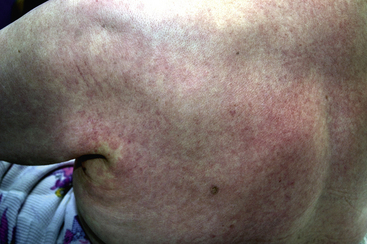56 Drug-induced skin disorders
Diagnosis
It is often difficult to determine the cause of a drug-induced eruption because:
Definitive diagnosis of a drug-induced dermatosis would require drug re-challenge; however, this is not recommended due to the possibility of provoking a more severe reaction on second exposure (Li Wan Po and Kendall 2001).
Drug-induced skin disorders
Drug reactions causing changes to skin function
Abnormal photosensitivity
Drug-induced photosensitivity can be either phototoxic or photoallergic (Box 56.1). Phototoxic reactions, which are more common, resemble severe sunburn and can progress to blistering. They are dose dependent for both the drug and sunlight, occur within 5–15 h of taking the drug and subside quickly on drug withdrawal. Photoallergic rashes are usually eczematous, but may be lichenoid, urticarial, bullous or purpuric. They are not dose dependent and occur following exposure to normal amounts of sunlight exposure. The onset can be delayed by weeks or months, while recovery is often slow following drug withdrawal. Rarely, a photoallergic state can persist for years after the drug responsible has been discontinued.
Pigmentary changes
The skin’s colour can be altered by drugs: hyper-pigmentation, hypo-pigmentation and discoloration can all potentially be induced by a variety of medicines (see Fig. 56.1 and Table 56.1). Pigmentary changes can be widespread or localised. The most common examples of localised pigmentation are the facial blue–black pigmentation in individuals on amiodarone or minocyline, and melasma facial pigmentation occurring in some women taking the combined oral contraceptive pill. Generalised pigmentary change induced by drugs is rare, but can occur with chemotherapeutic agents such as bleomycin. This may have the appearance of generalised hyper-melanosis, or may take on a more flagellate appearance with multiple linear areas of hyper-pigmentation.
| Drug | Pigmentation |
|---|---|
| Amiodarone | Blue-Grey |
| Anticonvulsants | Brown |
| Antimalarials | Blue-Grey |
| β-Blockers | Brown |
| Imatinib | Hypo/Hyperpigmentation |
| Imipramine | Blue/Grey |
| Mepacrine | Blue/black |
| Methyldopa | Brown |
| Oral contraceptives | Brown spots/patches |
| Phenothiazines | Brown/Blue-Grey |
| Psoralens | Brown |
| Tetracyclines | Blue-Black |
Hair changes
Loss of hair
Drug-induced alopecia (Box 56.2) may be partial or complete. The temporal relationship between the introduction of the drug and the subsequent loss of hair depends on the part of the hair cycle with which the drug interferes. Cytotoxic drugs interfere with the ‘anagen’ or growth phase of the hair cycle, and so loss is rapid and complete; it begins shortly after administration of the drug and the effect is dose dependent and fortunately reversible, but a delay of several weeks is common before regrowth begins.
Excessive hair
Hirsutism is excessive hairiness, especially in women, in the male pattern of hair growth, while hypertrichosis is the growth of hair at sites not normally hairy. Both conditions can be drug induced and in some cases the same drug can produce both patterns of hair growth (see Box 56.2). The capacity of minoxidil to produce hypertrichosis was noted during early trials of this drug as an antihypertensive. It is infrequently used for its originally intended purpose, as it produces profound postural hypotension, but its most noticeable side effect has been exploited as a topical preparation for the treatment of male pattern baldness.
Mild drug-induced skin disorders
Drug-induced exanthems
A drug-induced exanthem (widespread rash) is the most common type of drug reaction in the skin. Exanthems are characterised by erythema (redness) and may be morbilliform (resembling measles) or maculopapular (a mixture of flat and raised areas) (see Fig. 56.2). Less frequently there may be blisters, which may be small (vesicles) or larger (>5 mm, bullae), and the skin may feel hot, burning or itchy.
Most drug-induced exanthems begin within 7 days of commencing a drug, the mechanism being a delayed (type IV) hypersensitivity (Burns et al., 2004). If the drug can be identified, it should be stopped, appropriate symptomatic relief instituted with antihistamines and topical steroids. A clear record of the reaction should be made in the patient’s notes. Both the patient and his primary care doctor should be made aware of the reaction for the purposes of future avoidance.
An exanthematous reaction commonly occurs following administration of ampicillin (or its derivatives, including amoxicillin) to patients suffering from glandular fever (infectious mononucleosis). It does not usually represent a true penicillin allergy, but a complex interplay between viral factors (infectious mononucleosis being caused by Epstein Barr virus) and drug epitopes (Burns et al., 2004). This reaction to the drug would not be expected to be seen in the same patient in the absence of the virus.
Urticaria and angioedema
Urticaria, also known as hives, describes the appearance of red, itchy weals on the skin (Fig. 56.3). Angioedema is a more serious, related condition in which the patient develops deep soft-tissue swellings, mostly notably on the face. Urticaria and angioedema can be either allergic, a reaction between an antigen and specific mast cell-bound IgE, or non-allergic. Drugs are recognised triggers of urticaria and angioedema (Box 56.3) and can also exacerbate pre-existing urticaria. The most important culprits are the NSAIDs and opiates, both of which lower the threshold for mast cell degranulation. ACE inhibitors and angiotensin receptor blockers (ARBs), for example candesartan, can provoke angioedema in a susceptible individual.










